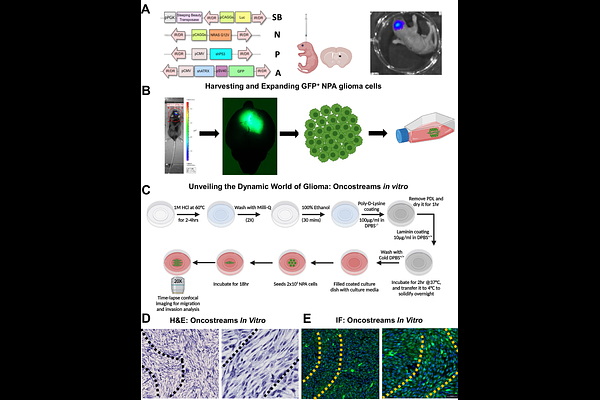Modeling Glioma Oncostreams In Vitro: Spatiotemporal Dynamics of their Formation, Stability, and Disassembly

Modeling Glioma Oncostreams In Vitro: Spatiotemporal Dynamics of their Formation, Stability, and Disassembly
Faisal, S. M.; Clewner, J. E.; Stack, B.; Varela, M. L.; Comba, A.; Motsch, S.; Castro, M. G.; Lowenstein, P. R.
AbstractGlioblastoma (GBM), known for its invasive nature, remains a challenge in clinical oncology due to its poor prognosis. Only 5% of patients live past 2 years. The extensive intra-tumoral heterogeneity, combined with aggressive infiltration into surrounding healthy brain tissue limits complete resection and reduces the efficiency of therapeutic interventions. In previous studies using ex-vivo 3D explants and in-vivo intravital imaging, we discovered the existence of oncostreams. Oncostreams are accumulations of nematically aligned elongated spindle-like cells constituted by both tumor and non-tumor cells. We observed a direct correlation between the density of oncostreams and glioma aggressiveness, in genetically engineered mouse glioma models, in high-grade human gliomas, and especially in gliosarcomas. Oncostreams play a pivotal role in the intra-tumoral distribution of both tumoral and non-tumoral cells, potentially facilitating collective invasion of neighboring healthy brain tissue. We further identified a unique molecular signature intrinsic to oncostreams, with a prominent overexpression of COL1A1, MMP9, ADAMts2, and ACTA2 - pivotal genes influencing glioma\'s mesenchymal transformation and potential determinants of tumor malignancy. COL1A1 inhibition in genetic mouse gliomas resulted in the elimination of oncostreams and induced significant changes in the tumor microenvironment, a reduction in mesenchymal-associated gene expression, and prolonged animal survival. Based on this foundation, we endeavored to model glioma oncostreams in vitro, evaluating the potential of various pharmacologic agents on the formation and organization of oncostreams. Using an optimized workflow, oncostreams were established using GFP+ NPA cells (NRAs\\shP53\\shATRX) derived from a genetically engineered mouse model utilizing the Sleeping Beauty transposon system. In-depth global and localized statistical analysis employing Julia programming and R Studio based in-house scripts provided insights into the behavior and organization of glioma cells. Our in vitro model led us to probe the impact of factors like cell density, cell morphology, collagen coating, exposure to neurotransmitter agonists, and changes in calcium levels. We also explored interventions targeting specific cytoskeleton structures like non-muscle myosin II B and C, myosin, actomyosin, and microtubules on oncostream formation and organization. In conclusion, our data provide novel information on patterns of glioma migration, which will inform mechanisms of glioma collective invasion in vivo. Through quantitative analysis of these pathologically aggressive and invasive structures, we highlight the importance of potential anti-invasion targets in improving outcomes for GBM patients. Integrating anti-invasive molecules with conventional treatments could significantly enhance clinical benefits.